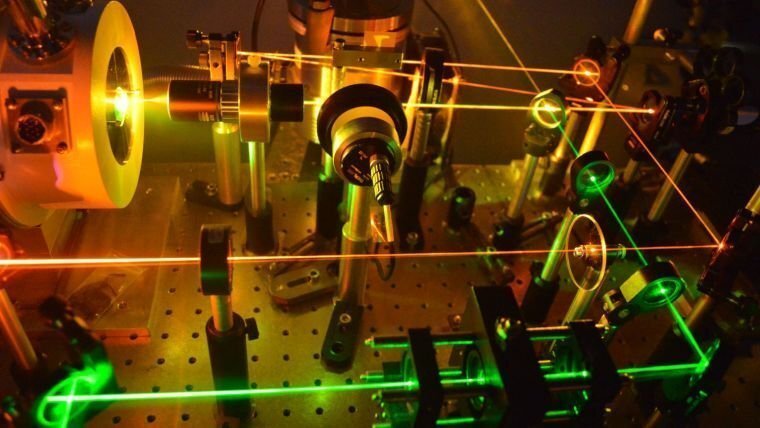
Prof. Dr. Giancarlo Soavi
Image: PrivateProf. Dr. Giancarlo SOAVI
Email: giancarlo.soavi@uni-jena.de
Phone: +49 3641 9-47410
Giancarlo Soavi is a Professor at the Institute for Solid State Physics of the Friedrich Schiller University Jena, where he leads the Group of UltraFast Optical Spectroscopy (GUFOS). He received his PhD in Physics in 2015 from Politecnico di Milano and worked as a Research Associate at the Cambridge Graphene Centre (University of Cambridge, UK) from 2015 to 2018. He is the leader of the “Lasers and Sources” working group of the 1b€ European project Graphene Flagship.
The Group of UltraFast Optical Spectroscopy (GUFOS) studies the dynamical and nonlinear optical processes occurring in quantum confined systems following interaction with ultrashort (fs) pulses thanks to the development of complex optical setups and experimental methods, such as time-resolved pump-probe spectroscopy, photocurrent, photoluminescence and nonlinear microscopy. We combine advanced optics and photonics with state-of-the-art electronics and cryogenic measurements. Current research focuses on gate-tuneable nonlinear optical effects (SHG, THG) in graphene and related 2D materials and on time-resolved optical and opto-electronic spectroscopy of quantum confined systems such as 2D materials, layered heterostructures, CNTs and GRNs.
Research Areas
The research group of Dr. Soavi focuses on the study of the ultrafast opto-electronic and nonlinear optical properties of nanoscale and quantum confined systems, including carbon nanotubes and graphene nanoribbons, metallic nanoparticles, 2D perovskites and 2D materials. Research interests include:
- Ultrafast electron and exciton dynamics in 2D materials and related heterostructures
- Nonlinear optical imagining and harmonic generation in quantum confined systems
- Fabrication of opto-electronic devices based on 2D materials
- Development of novel methods for the study of ultrafast dynamics at the nanoscale
Teaching Fields
Dr. Soavi teaches two elective courses designed for MSc students in physics and photonics:
- Graphene: electronic and optical properties
- Nonlinear optical properties of 2D materials
Research Methods
The Group of UltraFast Optical Spectroscopy (GUFOS) combines different techniques for the fabrication and characterization of devices based on 2D materials and for the study of the ultrafast dynamics and nonlinear optical properties of nanoscale systems. These include:
- Microscope for deterministic transfer of 2D materials
- 10K clean room for nano-fab and device fabrication
- Custom-built Raman and photoluminescence microscope
- MHz repetition rate pump-probe spectroscopy
- Custom-built nonlinear optical microscope
- Cryostat for optical measurements from room temperature to 4K
Recent Research Results
In the last years, the research of Dr. Soavi focused on two major activities. The first deals with the study of the ultrafast dynamics and coherent phonons excitation in quantum confined systems. Experiments in this field were performed with custom-built pump-probe systems, with temporal resolutions ranging from 10fs to 100 fs. In pumpprobe experiments, a first ultrashort pulse (pump) triggers a dynamical process which is subsequently detected by looking at the changes in the absorption or transmission of a second ultrashort pulse (probe). By changing the delay between the pump and the probe it is possible to follow in real time the evolution of the excited state of the system under investigation. This technique can be applied to a vast range of samples and it is widely used in chemistry, biology and solid-state physics. In particular, Dr. Soavi designed and implemented experiments to study the ultrafast optical response of quantum confined systems, including the investigation of the pseudospin dynamics in graphene [1], the inter- and intra-valley scattering and spin-flip in semiconducting 2D materials [2], the out-of-plane heat transfer in layered heterostructures [3], the ultrafast mechanism of exciton-exciton annihilation and the subsequent formation of biexcitons in graphene nanoribbons [4] and the ultrafast response and charge carrier photogeneration in semiconducting carbon nanotubes [5]. Besides the ultrafast dynamics of electrons and excitons, pump-probe experiments have been performed to study the coupling between excitons and phonons in 2D materials [6] and the mechanical coherent oscillation of metallic nanoparticles [7].
More recently, the research of Dr. Soavi focused on the fundamentals and applications in the field of nonlinear optics, harmonic generation and frequency conversion. In this context, he achieved the first experimental demonstration of ultrabroadband and gate-tuneable third harmonic generation in graphene [8] and studied the impact of hot-electrons in harmonic generation with ultrashort pulses [9]. Dr. Soavi also designed and implemented four-wave-mixing experiments for ultra-sensitive gas detection using graphene integrated photonic devices [10] and second harmonic generation experiments to study symmetry breaking in layered perovskites [11].
[1] Trushin et al., Phys. Rev. B 92, 165429 (2015).
[2] Wang et al., Nano Lett. 18, 6882 (2018).
[3] Tielrooij et al., Nature Nanotechnol. 13, 41 (2018).
[4] Soavi et al., Nature Commun. 7, 11010 (2016).
[5] Soavi et al., Adv. Opt. Mater. 4, 1670 (2016).
[6] Trovatello et al., ACS Nano 14, 5700 (2020).
[7] Soavi et al., ACS Nano 10, 2251 (2016).
[8] Soavi et al., Nature Nanotechnol. 18, 6882 (2018).
[9] Soavi et al., ACS Photon. 18, 6882 (2018).
[10] An et al., Nano Lett. 9, 6473 (2020).
[11] Schmitt et al., J. Am. Chem. Soc. 142, 5060 (2020).
